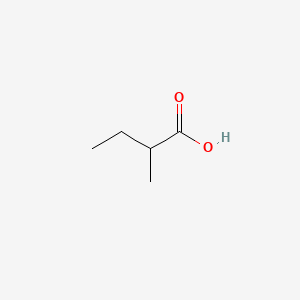| MeSH term | MeSH ID | Detail |
|---|---|---|
| Adenocarcinoma | D000230 | 166 associated lipids |
2-Methylbutanoic acid
2-Methylbutanoic acid is a lipid of Fatty Acyls (FA) class. The involved functions are known as Binding (Molecular Function), Oxidation, isoleucine catabolic process, Anabolism and physiological aspects. 2-methylbutanoic acid often locates in Membrane, soluble and host. The associated genes with 2-Methylbutanoic acid are Homologous Gene, Genome, NKS1 gene, HM13 gene and ACSM1 gene. The related lipids are Fatty Acids, Butyric Acids, branched chain fatty acid, Propionate and 2-methylvalerate.
Cross Reference
Introduction
To understand associated biological information of 2-Methylbutanoic acid, we collected biological information of abnormalities, associated pathways, cellular/molecular locations, biological functions, related genes/proteins, lipids and common seen animal/experimental models with organized paragraphs from literatures.
What diseases are associated with 2-Methylbutanoic acid?
There are no associated biomedical information in the current reference collection.
Possible diseases from mapped MeSH terms on references
We collected disease MeSH terms mapped to the references associated with 2-Methylbutanoic acid
PubChem Associated disorders and diseases
What pathways are associated with 2-Methylbutanoic acid
There are no associated biomedical information in the current reference collection.
PubChem Biomolecular Interactions and Pathways
Link to PubChem Biomolecular Interactions and PathwaysWhat cellular locations are associated with 2-Methylbutanoic acid?
Visualization in cellular structure
Associated locations are in red color. Not associated locations are in black.
Related references are published most in these journals:
| Location | Cross reference | Weighted score | Related literatures |
|---|
What functions are associated with 2-Methylbutanoic acid?
Related references are published most in these journals:
| Function | Cross reference | Weighted score | Related literatures |
|---|
What lipids are associated with 2-Methylbutanoic acid?
Related references are published most in these journals:
| Lipid concept | Cross reference | Weighted score | Related literatures |
|---|
What genes are associated with 2-Methylbutanoic acid?
Related references are published most in these journals:
| Gene | Cross reference | Weighted score | Related literatures |
|---|
What common seen animal models are associated with 2-Methylbutanoic acid?
There are no associated biomedical information in the current reference collection.
NCBI Entrez Crosslinks
All references with 2-Methylbutanoic acid
Download all related citations| Authors | Title | Published | Journal | PubMed Link |
|---|---|---|---|---|
| Tokitomo Y et al. | Odor-active constituents in fresh pineapple (Ananas comosus [L.] Merr.) by quantitative and sensory evaluation. | 2005 | Biosci. Biotechnol. Biochem. | pmid:16041138 |
| Novák J et al. | Nitrogen regulation of fatty acids and avermectins biosynthesis in Streptomyces avermitilis. | 1992 | FEMS Microbiol. Lett. | pmid:1612418 |
| Hamilton JG et al. | Identification of a male-produced aggregation pheromone in the western flower thrips Frankliniella occidentalis. | 2005 | J. Chem. Ecol. | pmid:16222777 |
| Kim J et al. | 4,8-Dimethyldecanal, the aggregation pheromone of Tribolium castaneum, is biosynthesized through the fatty acid pathway. | 2005 | J. Chem. Ecol. | pmid:16222778 |
| de Souza MD et al. | Characterization of cachaça and rum aroma. | 2006 | J. Agric. Food Chem. | pmid:16417309 |
| Ganesan B et al. | Identification of the leucine-to-2-methylbutyric acid catabolic pathway of Lactococcus lactis. | 2006 | Appl. Environ. Microbiol. | pmid:16751541 |
| Lee I and Zaera F | Chiral templating of surfaces: adsorption of (S)-2-methylbutanoic acid on Pt(111) single-crystal surfaces. | 2006 | J. Am. Chem. Soc. | pmid:16819884 |
| Stacchiola D et al. | Requirements for the formation of a chiral template. | 2005 | J Phys Chem B | pmid:16866451 |
| Manrique G et al. | Chemical communication in Chagas disease vectors. Source, identity, and potential function of volatiles released by the metasternal and Brindley's glands of Triatoma infestans adults. | 2006 | J. Chem. Ecol. | pmid:16902820 |
| Kaler G et al. | Olfactory mucosa-expressed organic anion transporter, Oat6, manifests high affinity interactions with odorant organic anions. | 2006 | Biochem. Biophys. Res. Commun. | pmid:17094945 |
